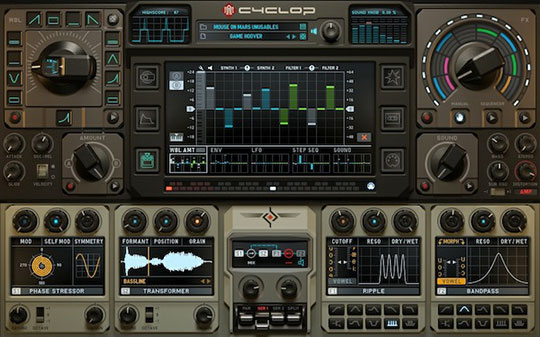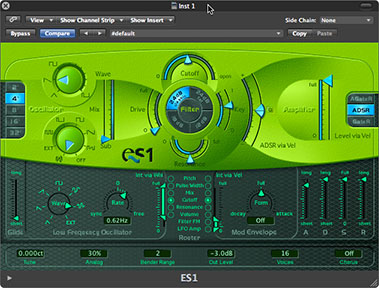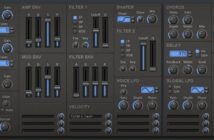The Get That Pro Sound Ultimate Guide to Bass Ebook Available Now>>
To mark the release of the new Get That Pro Sound Ultimate Guide to Bass, we’ve put together a roundup of our favourite synth plugins for use when creating everything from warm to sharp to just plain awesome basslines and sounds.
As always, it’s been a challenge to keep it down to 10, but this final selection is for us the absolute cream of the crop. Whether you’re after biting Dubstep attack, rich analogue fatness or the expressive feel of a real string bass instrument, we’ve got you covered. All of these VST instruments represent the pinnacles of sound quality, character, usability and fun in each of their particular approaches to bass sounds (and some of them will handle any task you care to throw at them). With any if these plugins to hand, you’ll be able to make the most of all the tips and techniques discussed in the Ultimate Guide, and be well on your way to crafting the perfect basslines, sub-bass and general low-end goodness that your tracks deserve.
My thinking for this list was simple: yes, while processing such as compression, saturation and EQ, not to mention the overall construction of a mix and where the bass parts sit in that context are important, what are the best originating sources for electronic or virtual acoustic bass sounds?
“Starting at the beginning of the production process, what are the very best VST plugin sources for bass that will give every producer the best possible odds of creating successful bass elements in their chosen styles and genres?”
A Quick Salute To The Hardware
 As is now tradition here at GTPS, we’d like to mention some of the analogue/hardware classics that are still such an influence on the software instruments, effects and processors we all now use every day. First and foremost, putting this list together it became clear just how much of an (ironically) large shadow the Minimoog casts over plugin synths today. This diminutive model was released in 1970 in response to the growing trend amongst artists of incorporating fairly unwieldy modular synths into their productions and live performances: by taking only the most important parts of a modular synth and placing them in a compact frame with an incredibly intuitive interface (look, no patch cords!), a legend with a sound entirely its own was born. It’s one of the great examples of necessity being the mother of invention.
As is now tradition here at GTPS, we’d like to mention some of the analogue/hardware classics that are still such an influence on the software instruments, effects and processors we all now use every day. First and foremost, putting this list together it became clear just how much of an (ironically) large shadow the Minimoog casts over plugin synths today. This diminutive model was released in 1970 in response to the growing trend amongst artists of incorporating fairly unwieldy modular synths into their productions and live performances: by taking only the most important parts of a modular synth and placing them in a compact frame with an incredibly intuitive interface (look, no patch cords!), a legend with a sound entirely its own was born. It’s one of the great examples of necessity being the mother of invention.

It’s interesting that another classic synth, the Roland TB-303, didn’t become famous for fulfilling it’s originally intended purpose. It was brought out in 1981 as a bass accompaniment for solo guitarists to use when practicing or playing small gigs. However, it was generally regarded that the 303 sounded nothing like a real bass, and only 10,000 units were produced. And that might have been the end of the 303 story if not for the emergence of House music in Chicago and Techno in Detroit: the 303 was re-appropriated by DJs and producers who saw the possibilities of pushing the sounds and filter controls of the machine to create a new breed of ‘acid’ squawks and squelches.
The Top 10 Best VST Synth Plugins For Bass: The List
(in no particular order)
1. Native Instruments Massive
While many of the synth plugins on this list are modelled on classic hardware, Massive is an altogether different beast, taking bits and pieces of features and ideas from all over the place. Aimed at providing the kind of power and flexibility offered by NI’s other synths like Absynth and FM8 but with a more straightforward programming and modulation interface, it’s fair to say that it’s become so popular that electronic music – and specifically Dubstep and it’s close siblings – wouldn’t sound like it does today without this pretty ubiquitous synth. This is largely down to the distinctive sounds generated by the wavetable oscillators, and also the visual, ‘drag and drop’ modulation section where you can create the kind of complex LFO-led dynamics it would take considerably more time and/or expertise to program on most other synths. But take the time to get under the skin of Massive and it can do a lot more than your average wobble bass too.
Native Instruments FM8
The other ‘go-to’ synth for bass from the Native Instruments stable, FM8 is an update of FM7, which itself was modeled on the legendary (and legendarily tricky to program) Yamaha DX7. Fortunately, the modulation style and general layout make much more sense in plugin form, and FM8 definitely rewards time spent learning it’s features.
BUY NOW both Massive and FM8 are included in the awesome Native Instruments Komplete 10 bundle via Amazon.2. Spectrasonics Trilian
It took me a while to discover Trilian (eventually through Spectrasonics flagship synth Omnisphere), but I’m so glad I did. It’s a ‘bass module’ rather than a straight-up synth plugin, offering hundreds of different bass instruments, everything from sampled Fender Jazz Bass guitars to the Moog Taurus Pedal to loads of original instruments created, layered and modulated by the Spectrasonics team themselves (and all customizable). What is difficult to get across when describing Trilian (or Omnisphere for that matter) is how playable the instruments are: for example, the bass guitars include every possible articulation and Trilian even inserts sporadic string squeal between notes for incredible authenticity.
This one is especially popular among film and game composers for it’s ability to cover pretty much every base with a certain classiness and flexibility, but if you’re making EDM or producing a band and in need of some additional but authentic bass parts that could be mixed convincingly with real players, this could still be the only source of bass instruments you’ll ever need.
BUY NOW via Amazon.3. u-he Diva
u-he and it’s founder Urs Heckmann have a special place in the hearts of many producers for their impeccably designed collection of high quality synths. Diva arguably represents something of a new benchmark in plugin synths to rival the analogue classics: it owes more than a passing nod to the Minimoog (more of which below), and it’s richness of sound – particularly the filters – is excitingly ‘musical’ in that analogue way. Diva doesn’t have too many gimmicky features to speak of that might normally make it feel less interesting than other options, but in practice it’s directness of purpose and pure sonic quality only makes it more refreshing and usable.
BUY NOW via Plugin Boutique.u-he ACE and zebra2
4. Cakewalk z3ta+ 2
The original z3ta+ from rgc:audio was a favourite for drum & bass, and with version 2 from Cakewalk things only got better for EDM producers. The core of z3ta+ 2 are the six wavetable oscillators, and with the accompanying filter, modulation and effects sections you can go just about as deep as you want to craft everything from glassy to filthy bass sounds. There’s something dependable about z3ta+, the sense that it can handle anything with finesse, that still makes it my ‘go-to’ synth.
BUY NOW via Plugin Boutique or Amazon.5. Rob Papen Predator 2 / Linplug Spectral
Predator 2 is one of the more recent synths from Rob Papen, creator of the classic Albino3 soft synth which was a long-time favourite and staple of many producers synth collections. Albino3 was a collaboration with Linplug, and you should also check out their current flagship Spectral synth.
 We must also cover Rob Papens other synths, with particular mention here to SubBoomBass, clearly a bass specialist.
We must also cover Rob Papens other synths, with particular mention here to SubBoomBass, clearly a bass specialist.
 6. Arturia Minimoog V / GForce MINIMONSTA
6. Arturia Minimoog V / GForce MINIMONSTA
As one of the most iconic classic synths in every sense, it’s not surprising that there are many plugin synths modeled on the MiniMoog. Whilst Trilian and Diva (above) both ‘do’ great Minimoog, if you want a standalone model either of these two will fit the bill. There’s precious little to choose
from between them in terms of faithfulness and sound quality compared to the original hardware – I went for the Minimonsta partly because I love everything Ohm-Force (this is a collaboration between them and G-Media) and I dig the more moody interface, but Arturia’s reputation, for all of their classic synth emulations, is also pretty faultless. Whichever you go for, they both ooze character and charm.
BUY NOW Arturia Mini V via Plugin Boutique. 7. FabFilter Twin 2
7. FabFilter Twin 2
You’ll know from previous posts that I’m a big fan of FabFilter plugins, and their take on the synthesizer doesn’t disappoint. Twin 2 features the great filters one would expect from the company name, but as well as the great sound quality its the innovative interface with the highly usable drag and drop-style modulation options that really make it an all-round winner for creating phat basses with plenty of movement and character.
BUY NOW via Plugin Boutique.8. D16 Phoscyon
We covered the best Minimoog emulators above, but what about the best plugin version of another iconic bass synth, Rolands TB-303? My vote goes to D16’s Phoscyon: much like all D16 plugins, Phoscyon lets you recreate the classic and familiar analogue sounds of the unit that helped define House, Techno and the rest of electronic music, but it’s also not so much of a slave to rigid emulation that it’s afraid to add a few new features and improvements too, especially for live use. If you’re sick of using ‘acid’ bass samples or you just want to try writing House tracks the way the genres originators would have done (it does make you write differently, and you gain a fresh insight into how and why classic tracks sound the way they do), this one is for you.
Also see: Audiorealism’s Bass Line 3 (ABL3) for another well-regarded 303 emulation. Also check out another of D16’s synth plugins, LuSH-101, which is based on the hardware Roland SH-101.
9. Sugar Bytes Cyclop
Cyclop is another monophonic synth plugin, but this one is a pretty unique monster. It incorporates mid/side processing as standard on frequencies between 250Hz-4kHz, which contributes to it sounding consistently wide and impactful, and with it’s Wobble and modulation morphing knobs (the two big ones) you can create complex movement and dynamics not just easily but in a very fun way (something that cannot be said of all synth modulation setups). With the rapid (and randomized if you want) blending between modulation types and with the cleverly chosen effects on offer, Cyclop is great (and essentially designed for) modern hard electronic styles.
BUY NOW via Plugin Boutique.10. Your DAWs synths
Whether you’re a user of Ableton Live, Logic Pro or any other major music production software, there’ll be at least one synth bundled with your DAW that can be used to create some outstanding bass sounds. It’s often surprising what can be achieved with these sometimes relatively basic-looking synths, but the real power lies in mastering the essential principles behind synth programming: take a little time to grasp the fundamentals that go into making great bass sounds and you might be surprised how your approach and choice of tools develops along with your skill.
What’s your favourite instrument for synth bass? Leave a comment below, and make sure to check out the new entry in the Get That Pro Sound Ultimate Guides series: it covers everything to do with creating, processing and mixing bass and other low-frequency elements in your tracks:






















22 Comments
I use MAGIX Music Maker (I know). In the latest version they’ve added a new synth, DN-e1. So far i’m getting great results, nice low end punch :)
Never apologize for the equipment you use. Great things have come from inauspicious beginnings.
this list absolutely missed 2 giants :
sylenth1 and surge !
100% (Y) sylenth1 is the best synth of all time in my own opinion, then comes cyclop and Nexus.
I’m not a fan when it comes to Native instruments.
Derek and Hassan, yep Sylenth1 could certainly be included in a future update :)
If only Sylenth would update I’d say the same. Mac producers are still being shafted by Lennar Digital. Before Logic Pro X came out they never once said a word in response to all their Mac customers emailing asking them to update to 64bit.
actually they have bundled ’32 lives’ along with sylenth, a program which allows DAWs to detect 32-bit plug ins
Guess they figured they already had EDM covered.
This was an insightful list, especially since it was targeted towards bass sounds! George, do you think you could possibly come up with a top synths list for all the different categories of synthesis? That would be so fantastic!
Thanks David – and I’ll look into creating a list with the best synths for each type of synthesis. It’s a cool idea, might be a big list though so I’ll have to see how to keep it manageable :) Stay posted! Cheers
George,
I recommend you split off the 101 from your 303 entry; I’d love to see your thoughts on luSH101 vs. TAL Bassline 101 &c.
Also, since Albino is essentially not an option for those starting out, I’d love to see your thoughts on LinPlug Spectral. I personally love it, but from what I’ve read, it is not a replacement for Albino.
Cheers!
– Wes
Thanks Wes, yeah I always try to cram in more than the ’10’ highlighted entries when there are so many great alternatives – you’re right, in another incarnation of this list I could give equal praise to luSH101 and Phoscyon :)
Will also let you know when I get around to trying out Spectral – thanks for the reminder – and glad it sounds like it’s doing the job for you :)
Cheers!
My top plugins:
1.spectrasonics omnisphere (cpu hog)
2.spire
3.Sylenth1
4.Korg m1
N.I Monark is good fun, great analog sound, got it with Komplete 9 (run’s in the free Reaktor player also)
In regards to jack of all trade synths, Sylenth is a capable synth, buts for my ears it puts out a pretty cold harsh digital sound when compared to the likes of the VirusTI, Spire or Dune II and ended up dropping it. The amount of patches make it a appealing but thats just not good enough of an excuse. Depends on style and what you get away with.
Massive, Razor(reaktor), Dune II and Zebra2 I think are absolutely amazing all-round capable soft synths that sound great and are my current laptop goto synths. In particular, check out Dune II if you haven’t.
Omnishpere and Nexus are great for quick access sampled PADs, wouldn’t use a sampler for synths though, no point and no control and they just die in the mix.
Z3ta deserves its mention as its almost the forgotten synth, but a fellow producer runs a computer just for that. It seemed to loose its name after cakewalk branded it.
Dave, thanks for your excellent selection and explanations as to your thinking behind them. Yes z3ta+ was one of my own first synths that I learned a lot of programming stuff on, so it always has a special place for me :) and the z3ta+2 was a welcome update. But yes, perhaps it’s thunder was slightly unfairly stolen by some other amazing synths that have come out since, several of which you mentioned…
It’s interesting and a significant point, what you’re saying about synths for different purposes and places in the mix: some colder, more digital-sounding synths can bite through a track quite appropriately, whereas sometimes you just need that smoother analogue musicality for character and that’s going to sit comfortably in the mix context.
Cheers!
Harmor from Image Line, bundled with my version of FL Studio, is an absolute monster. Not to mention that you can use slide notes with it in fl, something you can’t do with vsts. The additive resynthesis engine is amazing. Sytrus (an amazing FM/RM synth, also from image line) follows, and then Serum from Xfer.
Good choices Donovan, plus one for Harmor, and Serum – will check out Sytrus now too :)
You probably made to spectrasonics some bucks. I was looking for a real sounding basses and this Trilian made my day. Thanks for nice overview mate. Thumb up.
WHY IS SERUM NOT ON THIS LIST???
What about NI Razor??
And Reaktor with it’s over 4000 instruments…
Anyone messed around with the novation bassstation vst??? Any thoughts?? Im thinking of buying a mostly dedicated bass vst and cant afford trilian atm. Leaning towards rob p subboobbass.